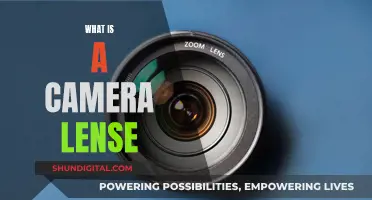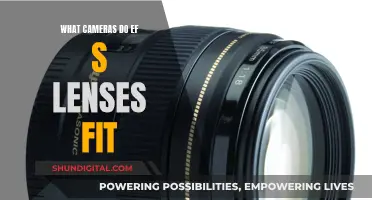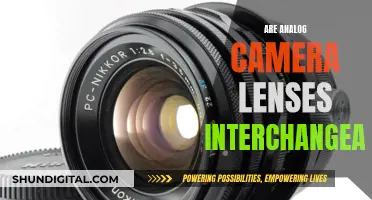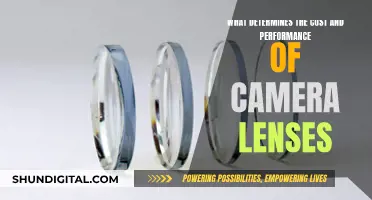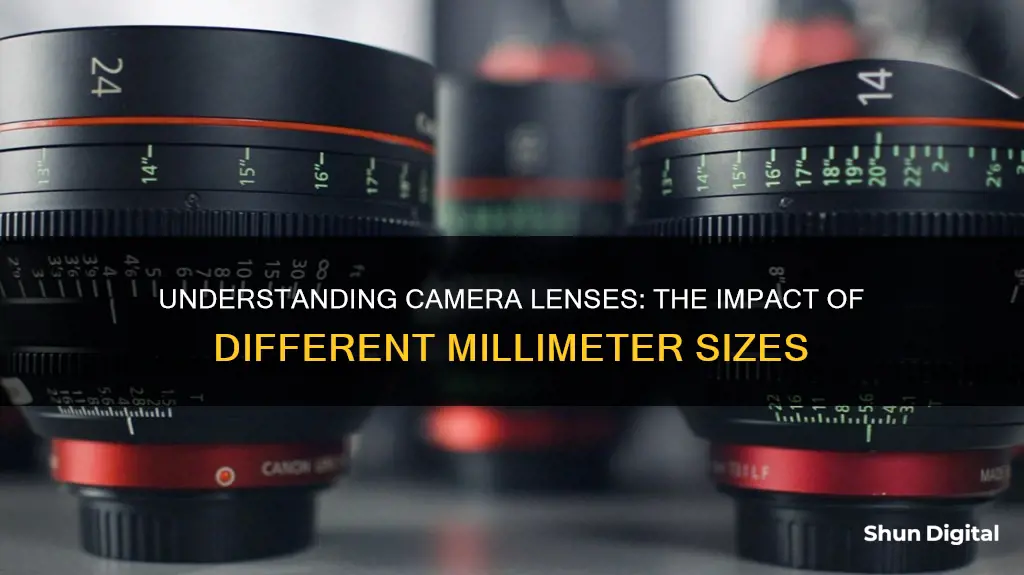
The 'mm' number on a camera lens is a measurement in millimetres of the focal length. This is the distance from the optical centre of the lens to the camera's sensor when focused on infinity. The focal length tells you how much of a scene will be captured in your photograph. A lower number in mm will give you a wider picture, while a bigger number in mm will be more zoomed in.
| Characteristics | Values |
|---|---|
| Focal length | The distance from the centre of the lens to the image focal point (or image sensor surface) |
| Focal length measurement | The measurement in mm of the focal length |
| Focal length and field of view | The focal length tells how much of the scene the camera will capture, i.e. the lens's field of view |
| Focal length and magnification | The higher the focal length, the higher the magnification of the image |
| Focal length and angle of view | The longer the focal length, the narrower the angle of view |
| Wide-angle lens | A lens with a short focal length |
| Telephoto lens | A lens with a long focal length |
| Prime lens | A lens with a fixed focal length |
| Zoom lens | A lens with a variable focal length |
What You'll Learn

Focal length: the angle of view or how much of a scene will be captured
Focal length is the main optical property of a camera lens. It is displayed in millimeters and by a number that looks like this: 35mm, 50mm, or 100mm. Lenses are named by these numbers and used when referencing different types of lenses.
Focal length is the angle of view, or how much of the scene will be captured, and the magnification of the image. The longer the focal length, or the higher the mm of the lens, the narrower the angle of view is and the higher the magnification of the image. Conversely, the shorter the focal length, or the lower the mm of the lens, the wider the angle of view and the lower the magnification of the image.
A lens with a 20mm focal length gives you a wide-angle view. A 50mm lens is considered standard, which is similar to the human eye. A 100mm focal length gives you a tighter, more magnified view.
A wide-angle lens has a short focal length and a telephoto lens has a long focal length. A wide-angle lens/short focal length (under 50mm) is good for taking in the broad span of a landscape, from near to far. They are good for when you want to capture more of a scene. A telephoto lens/long focal length (over 50mm) is good for bringing wildlife up close while allowing you the distance from your subject. Longer focal lengths are also good for portraits and sports.
The focal length of a lens is also affected by the size of the camera's image sensor. All lenses are measured off the full-frame sensor. If you have an APS-C camera or micro 4/3, these cameras have smaller sensors, so check the crop factor. It could be 1.5x for Nikon DX, Sony, Pentax, and Fuji, 1.6x for Canon, or 2.0x for micro 4/3. To figure out the effective focal length, take the mm of the lens multiplied by the crop factor. For example, 28 mm x 1.5 crop factor = 42 mm effective focal length. A crop sensor camera basically crops your scene in-camera, giving the impression of using a longer focal length.
RF Lenses: The Future of Mirrorless Photography?
You may want to see also

Focal length: the magnification of the image
The 'mm' number printed on a lens is a measurement in millimetres of the focal length. This measurement is taken from the optical centre of the lens to the camera's sensor when focused on infinity. The focal length of an optical system is a measure of how strongly the system converges or diverges light.
Focal length determines the magnification of the image. A shorter focal length or higher optical power is associated with lower magnification and a wider angle of view. Conversely, a longer focal length (lower optical power) leads to higher magnification and a narrower angle of view.
A lens with a short focal length is a wide-angle lens, which is good for taking in the broad span of a landscape, from near to far. They are good when you want to take in more of a scene. A wide-angle lens has a wide angle of view.
A lens with a long focal length is a telephoto lens, which is good for bringing wildlife up close while allowing you to maintain a distance from your subject. Longer focal lengths are also good for portraits and sports. A telephoto lens has a narrow angle of view.
The focal length of a lens determines the magnification at which it images distant objects. It is equal to the distance between the image plane and a pinhole that images distant objects the same size as the lens in question.
The Impact of Constant Lens Usage on Camera Performance
You may want to see also

Focal length: the distance from the centre of the lens to the image focal point
The focal length of a camera lens is the distance from the centre of the lens to the image focal point (or the image sensor surface). It is typically measured in millimetres (mm). The focal length of a lens determines its angle of view, or how much of the scene will be captured.
A lens with a short focal length is a wide-angle lens, which has a wide angle of view. This means that more of the scene will be captured, giving a wider view. Wide-angle lenses are ideal for landscape photography, interior shots, large group photos, and when working in confined spaces. They are also useful for capturing expansive vistas in landscape photography and are popular with vloggers who want to include a lot of their environment in the frame. Lenses with focal lengths below about 24mm (full-frame equivalent) are sometimes referred to as "ultra-wide".
A lens with a long focal length is a telephoto lens, which has a narrow angle of view. This means that less of the scene will be captured, giving a more zoomed-in view. Telephoto lenses are ideal for photographing distant subjects, such as wildlife, sports, or subjects that may be spooked by a photographer attempting to get close. They are also useful for bringing the background closer to the foreground, compressing the scene.
The focal length of a lens also affects the magnification of the image. A longer focal length will result in higher magnification, while a shorter focal length will result in lower magnification. This is why telephoto lenses are often used for close-up photography, such as macro photography or product photography.
The focal length of a lens is not the same as the actual physical length of the lens. It is a calculation of the optical distance from the point where light rays converge to form a sharp image of an object to the digital sensor or film at the focal plane in the camera. The focal length is determined when the lens is focused at infinity.
The focal length of a lens can be fixed or variable, depending on the type of lens. Prime lenses have a fixed focal length, while zoom lenses have variable focal lengths. Zoom lenses are more versatile and convenient, as they can cover a range of focal lengths in a single lens. However, prime lenses tend to be more compact and lightweight, and they often have larger maximum apertures, which can be advantageous in low-light conditions.
RF and EF Camera Lens Compatibility: What You Need to Know
You may want to see also

Focal length: the field of view
Focal length, measured in millimetres, is the main optical property of a camera lens. It determines the field of view, or how much of a scene will be captured, and the magnification of the image. The field of view is the angle of view, which is the width of the field included in the photo.
The longer the focal length, or the higher the mm of the lens, the narrower the angle of view and the higher the magnification of the image. This is known as a telephoto lens and is useful for portraits, sports, and other situations where you want to isolate your subject from the background.
The shorter the focal length, or the lower the mm of the lens, the wider the angle of view and the lower the magnification of the image. This is known as a wide-angle lens and is useful for landscapes, architecture, and other situations where you want to capture as much of the scene as possible.
A 50mm lens is considered standard as it is similar to the human field of vision. A lens with a focal length of 20mm or less is considered a wide-angle lens, while a lens with a focal length of 50mm or more is considered a telephoto lens.
It's important to note that the focal length of a lens is affected by the size of the camera's image sensor. For example, a 50mm lens on a camera with a smaller image sensor will behave more like a telephoto lens because the smaller sensor crops the image and makes the field of view narrower.
Choosing a Camera: Body, Lens, and Compatibility
You may want to see also

Focal length: the angle of view in relation to the human eye
Focal length is a key consideration when selecting a lens. It is the distance between the centre of a lens and the image sensor when the lens is focused at infinity. This distance is measured in millimetres (mm). The longer the focal length, the more the scene will be magnified.
Focal length is also related to the field of view, or angle of view, of a lens. Changing the focal length will change the field of view. The field of view is the area of the scene that is captured by the camera sensor, described in degrees of coverage in front of the camera. A lens with a shorter focal length will have a wider field of view, whereas a lens with a longer focal length will have a narrower field of view.
In relation to the human eye, a 50mm lens is generally considered to provide a perspective closest to how we see things. Standard lenses, with focal lengths of around 50mm, are said to have a "natural perspective" comparable to the human eye, making them a popular choice for travel and portrait photography.
However, it is important to note that the human eye has a field of view of around 120-200°, which is much wider than the angle of view provided by a 50mm lens. This is because each of our eyes can detect movement at the outer edges of our vision, even if we cannot pick out specific details.
Cleaning Your Fujifilm XP Waterproof Camera Lens
You may want to see also
Frequently asked questions
The 'mm' on a camera lens stands for millimetres and is a measurement of the lens's focal length. The focal length tells you how much of a scene the camera will capture. A lower mm number will give you a wider view, while a higher mm number will be more zoomed in.
A wide-angle lens has a short focal length, usually under 50mm, and can capture a broader scene. A telephoto lens has a long focal length, usually over 50mm, and captures a narrower field of view, which is useful for portraits or sports photography.
The focal length impacts the magnification of the image. A shorter focal length results in a lower magnification, while a longer focal length provides a higher magnification.
The choice of focal length depends on the type of photography you want to do. If you want to capture landscapes or architecture, a wide-angle lens with a shorter focal length is ideal. For portraits, sports, or any situation where you want to isolate the subject, a telephoto lens with a longer focal length is a better choice.


